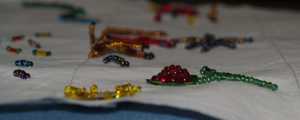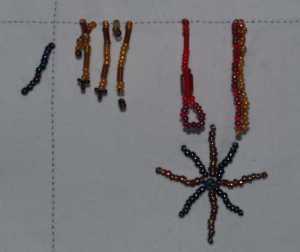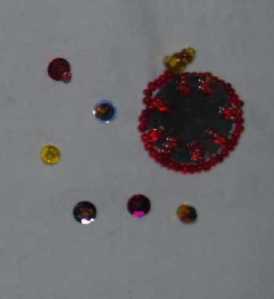Archive for February 2009
Scraps, scraps, everywhere there are scraps or my version of Scrap Busting!
Posted on: 26 February 2009
- In: quilting
- 8 Comments
Well, that may not be entirely true. To be honest, I do not have a large scrap collection, at least I don’t think so. I have them sorted as miscellaneous size and shape, strips (sorted again by width), squares (sorted by size), and pieced scraps (left overs from making blocks or trimmings of borders and such). Each “category” fits into a bin which is about 17″x12″x6½”. That is MY scraps.
My DD#2 on the other hand has been receiving bags of scraps from guild members. To be honest, her scraps fit into a box that 10 reams of paper fit in. But we haven’t completely sorted them yet.
How did I acquire these scraps?
It began with making quilts. A piece here, a piece there. Strip piecing leftovers. Trimming of half square triangles. All these bits of fabric, and haven’t even mentioned the strips and squares that have accumulated. What to do with them? Sort them of course. Strips sorted by side, 1”, 1½”, 2”, 2¼, 2½”, etc. Okay, now sort through the squares. Wow, still a lot of fabric bits. Okay, all the “dogs ears” and other various triangle bits. What am I going to do with the left over “pieced” bits, another bin for them.




Somehow, guild members thought DD#2 was into scraps (maybe she is, but you would never know it, trying to get her to do some quilting with me these days, is like pulling teeth, oh well, she’ll do it when she’s ready). So now, bags and bags of scraps!
One of the guild members suggested that DD#2 use the scraps using the mile-a-minute technique to make quilts. After a search on the internet, I found out how to make mile-a-minute quilts. The following are a couple of links that are “how-to’s” to make Mile-a-minute quilts. Do a search on Google, and you can find photos and more.
They are sort of like log-cabins, but not really. I started off with some scraps, and started cutting and sewing strips. I soon realized some of my strips, were not in fact strips, but chunks. Smaller than 22” long. They still worked for the beginning of the mile-a-minute quilts. I kept on sewing, and adding strips, in some cases sewing some of the chunks together (pieced on the diagonal for interest), and using them as strips. I kept sewing and pressing until the blocks were larger than 12” square, okay admittedly most were not square, but they were larger than 12” on either side.


Then trimmed down to 8½”. I used my 12½” square ruler, and tilted it, to get some very interesting results.



These are some of the finished trimmed blocks.


Egad, I was running out of strips, I didn’t really want to cut into my stash, what was I to do. As I was trimming the blocks I noticed a new pile of scraps accumulating. I’ll never have enough strips to add to these new blocks. Wait a minute, hold on, what if I take this pieced scrap, and sewed it to this pieced scrap… Hey, look at this.


Now I know what to do with that bin of leftover pieced pieces. I’ll just add them to what I have here. As I started this, I took a break, and looked up scrappy quilts on the internet. Apparently all those itty bitty pieces, are called “crumbs”. Very cool! So now I’m making some really crumby quilts.
I haven’t started it yet, but I can sew some of those triangle bits together to make wonky half square triangles… doesn’t matter if they match or not, and then sew them together to make a 4-patch block. Ohhh, the possibilities are endless.
I’m planning to use the blocks to make some quilts for the house, and possibly even a few for charity. I know I’ll have lots of scraps to make lots of blocks to make lots of quilts.
I’ve been teaching a dear friend how to sew and quilt. I think I’ll get her going on sewing some of these pieces and blocks together, will give her great practice on working on her ¼” seam. OH!, Speaking of ¼” seams… I was using mine, but I’m thinking, you don’t need to. Who cares if the seam is a tad more here or there? And for thread… I have a few bobbins (correction, “had”) of thread that were left over from other projects, and well, I used them up. Now I’m going through my thread, and using up left-over spools that were for other sewing projects.
What do you do with your scraps? Do you organize them? Perhaps give the mile-a-minute or crumb blocks a try, its a great way to take a break from larger projects.
-Alice
- In: quilting
- 4 Comments
I can’t believe how quickly time goes by. Lesson 4 of the online Beading Class was just posted on Friday, and I haven’t even written about Lesson 2. So here goes.
Lesson 2, I was so excited over. Well, truth be known, I’ve been excited each week, when the next lesson has been posted. I practice some of the techniques on my sampler, and I have even added a few to my Beading Experiment project. (Sorry no photos of that, until after our quilt show – a surprise for my fellow guild members).
Lesson 2 had several “neat” things. Fringes, a barnacle, stacks, and beading with sequins. I made my barnacle into a rose. Perhaps not the expected use of this technique, but it leant itself to it.

The barnacle is made by stitching 7 stacks (3 beads largest to smallest on top of each other), and then threading the top (stop) beads and pulling taut. The stacks pull inwards. With my Barnacle rose, I used 2 different green sequins as the “bud leaves” under each stack.
The stem is using a couched stitch. The sun is a largish sequin with seed beads and bugles making up the sun rays.

 These photos are side views of the barnacle.
These photos are side views of the barnacle.
Then it was on to fringes. These were so much fun. You can “end” the fringe in any bead design you like. The last fringe is called “double fringe”. You thread a number of beads, add your stopper bead, and then go back up the fringe, by adding 3 or 4 beads, then going back to a bead, then adding more beads, and going back, all the way up, until you reach the beginning of the fringe. I used two colours to really show this technique off. If you play with the beads a little, you can make them look like they are spiralling up the long fringe.
 As you can see in the photo, fringes have to be somewhat “long”, or they do not hang well. The 4th gold coloured one does not hang very well at all. The “starburst” or “fireworks” beads, are fringes, with the stop bead stitched down to the fabric. Spiders on Crazy quilting are sometimes made using this technique.
As you can see in the photo, fringes have to be somewhat “long”, or they do not hang well. The 4th gold coloured one does not hang very well at all. The “starburst” or “fireworks” beads, are fringes, with the stop bead stitched down to the fabric. Spiders on Crazy quilting are sometimes made using this technique.
My last part of Lesson 2, was somewhat straight forward, and also a little frustrating.
The stacked beads went well. I even added a sequin here and there to jazz it up. The couching around a larger sequin did not go very well for me. My beads “bubbled” up, which was probably because my tension was to taut. My photo is a little fuzzy at this end. And on top of everything, my larger sequin ended up situated much too close to a stacked bead.

Working with the sequins was a lot of fun, but at this point, I don’t see a use for them in my quilting projects. But I am not going to say never. A year ago, I didn’t think beading would ever become part of my quilting. You just never know what happens.
Not all quilts are meant for quilting. If you make wall-hangings or art quilts, consider adding a little beading. Not sure if the colours of the beads go with the quilt. Scatter a few over it.
Consider going up. What if you started with a larger bead, then added another, slightly smaller, and another even smaller? Instead of using a bugle, how would a square bead change the look.
As you are beading, be sure to take a little back stitch on the back or within the “sandwich”, just in case the thread weakens and breaks, rebeading 20 beads is much better than having to rebead 200.
Our guild has a library, with all sorts of books. One of them is Beading Basics – 30 Embellishing Techniques for Quilters by Mary Stori. The cover of the book is great! Beads around buttons. Fringes and so much more. If you are not able to take a class on Beading, I highly recommend this book. Even if you do take a class, I would still recommend it.
One of our guild members leant me a few of her books. One of them I had found on the internet, while I was looking for information. I thought it would be a great addition to our guild library. If you are looking for a book that has projects to do, as well as some gorgeous photos of beaded items, then Beaded Embellishment by Amy C. Clarke and Robin Atkins (Amazon has a neat feature, where you can see actual pages from a book) would be the one you are looking for. It does have a technique section, but for a beginner beader, this book may be a little too much.
Two absolutely beautiful books come to us from the UK. Bead Embroidery by Valerie Campbell-Harding and Pamela Watts, and Bead and Sequin Embroidery Stitches by Stan Levy, are absolute eye candy for beaders. The first is primarily on clothing, but the techniques can easily be done on quilted projects. The second book is a play-by-play. Some basic techniques, and then different variations of those techniques. He even discusses making one’s own designs.
The last book is by far my favourite. Embeadery – Using Classic Embroidery Stitches in Beadwork by Margaret Ball. It doesn’t have the glossy beautiful coloured pages like the others, but it is a technique enriched book. I believe it allows you to choose your colours, and allows you to imagine how different colours would work. Have you ever seen a project, and then had difficulty imagining it in any other colour? Some books and people, I suppose are limited to just a few simple techniques. This book takes embroidery stitches and turns them into beautiful beaded versions. She has a section of colured pages of stitches as well as a few projects. What I really like about this book, is it is NOT project based. If you were to get only one book on beading, I would highly recommend this one. It is a great beading reference book.
-Alice
Fat Quarter Quandry?
Posted on: 1 February 2009
- In: quilting
- 4 Comments
I’ve been blog surfing this morning… catching up on a few of the blogs I follow, and finding a few more.
One of the quilters introduced another blog, which I would like to share with you.
Sew, Mama, Sew! – For the month of February they will be posting a Fat Quarter topic each day – tutorials, information, swaps, and much much more. How cool is that.
I will be following along. I have a small’ish FQ collection, but I do wonder what to do with some of the fabrics… do I call them orphan FQ’s because they don’t go with anything?

This is an older picture… a few FQ’s have come and gone, but basically, that is all I have.
Do you have a FQ collection? What do you do with it?
-Alice

